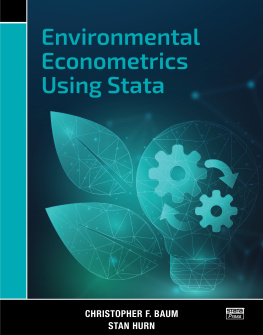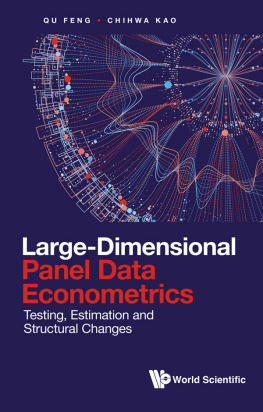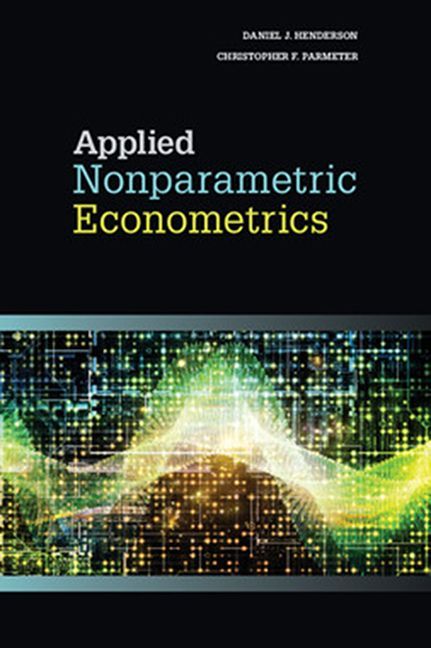Applied Nonparametric Econometrics
The majority of empirical research in economics ignores the potential benefits of nonparametric methods, while the majority of advances in nonparametric theory ignore the problems faced in applied econometrics. This book helps bridge this gap between applied economists and theoretical nonparametric econometricians. It discusses in terms that someone with one year of graduate econometrics can understand basic to advanced nonparametric methods. The analysis starts with density estimation and moves through familiar methods and on to kernel regression, estimation with discrete data, and advanced methods such as estimation with panel data and instrumental variables models. The book addresses issues that arise with programming, computing speed, and application. In each chapter, the methods are applied to actual data, paying attention to presentation of results and potential pitfalls.
Daniel J. Henderson is the J. Weldon and Delores Cole Faculty Fellow at the University of Alabama and a research Fellow at the Institute for the Study of Labor (IZA) in Bonn, Germany and at the Wang Yanan Institute for Studies in Economics, Xiamen University, in Xiamen, China. Formerly an associate and assistant professor of economics at the State University of New York at Binghamton, he has held visiting appointments at the Institute of Statistics, Universit Catholique de Louvain, in Louvain-la-Neuve, Belgium, and in the department of economics at Southern Methodist University in Dallas, Texas. He received his PhD in economics from the University of California, Riverside. His work has been published in the Economic Journal , the European Economic Review , the International Economic Review , the Journal of Applied Econometrics , the Journal of Business and Economic Statistics , the Journal of Econometrics , the Journal of Human Resources , the Journal of the Royal Statistical Society , and Review of Economics and Statistics .
Christopher F. Parmeter is an associate professor at the University of Miami. He was formerly an assistant professor in the department of agricultural and applied economics at Virginia Polytechnic Institute and State University and a visiting scholar in Dipartimento di Studi su Politica, Diritto e Societa at the University of Palermo. He received his PhD in economics from the State University of New York at Binghamton. His research focuses on applied econometrics across an array of fields, including economic growth, microfinance, international trade, environmental economics, and health economics. His work has been published in the Economic Journal , the European Economic Review, Health Economics , the Journal of Applied Econometrics , the Journal of Econometrics , the Journal of Environmental Economics and Management , and Statistica Sinica .
Applied Nonparametric Econometrics

DANIEL J. HENDERSON
University of Alabama
CHRISTOPHER F. PARMETER
University of Miami

32 Avenue of the Americas, New York, NY 10013-2473, USA
Cambridge University Press is part of the University of Cambridge.
It furthers the Universitys mission by disseminating knowledge in the pursuit of education, learning, and research at the highest international levels of excellence.
www.cambridge.org
Information on this title: www.cambridge.org/9781107010253
Daniel J. Henderson and Christopher F. Parmeter 2015
This publication is in copyright. Subject to statutory exception and to the provisions of relevant collective licensing agreements, no reproduction of any part may take place without the written permission of Cambridge University Press.
First published 2015
Printed in the United States of America
A catalog record for this publication is available from the British Library.
Library of Congress Cataloging in Publication Data
Henderson, Daniel J.
Applied nonparametric econometrics / Daniel J. Henderson, University of Alabama, Christopher F. Parmeter, University of Miami.
pages cm
ISBN 978-1-107-01025-3 (hardback) ISBN 978-0-521-27968-0 (pbk.)
1. Econometrics. 2. Nonparametric statistics. I. Parmeter, Christopher F. II. Title.
HB139.H453 2014
330.01 51954dc23 2014005138
ISBN 978-1-107-01025-3 Hardback
ISBN 978-0-521-27968-0 Paperback
Cambridge University Press has no responsibility for the persistence or accuracy of URLs for external or third-party Internet Web sites referred to in this publication and does not guarantee that any content on such Web sites is, or will remain, accurate or appropriate.
In memory of Susan Marie Henderson
D. J. H.
To my grandfather, Frank Samson Berch
C. F. P.
Contents

1 Introduction

1.1 Overview
The goal of this book is to help bridge the gap between applied economists and theoretical nonparametric econometricians/statisticians. The majority of empirical research in economics ignores the potential benefits of nonparametric methods and many theoretical nonparametric advances ignore the problems faced by practitioners. We do not believe that applied economists dismiss these methods because they do not like them. We believe that they do not employ them because they do not understand how to use them or lack formal training on kernel smoothing. Many theoretical articles and texts that develop nonparametric methods claim that they are useful to empirical researchers, which they often are, but many times the level of mathematics is too high for a typical economist or the detail with which the practical considerations are explained is not adequate except for those well versed in econometrics. At the same time, many of these articles and textbooks skip (or do not have room to include) the nuances of the methods which are necessary for doing solid empirical research.
Although nonparametric kernel methods have been around for nearly six decades, their use in economics journals did not become popular until the twenty-first century (noting that there were influential papers prior to 2000). In our opinion, two major developments have drastically increased the use of nonparametric methods in economics. The first is obvious: computing power. Without computers that can quickly provide estimates (coupled with efficient code), these methods are largely impractical for applied work. Of course, we cannot discount the importance of complementary statistical packages for nonparametric methods, such as the popular np package ( ) in the R language (2012). The combination of higher-powered computers and available software has done much to popularize the methods across academic fields.
For economics, the second reason we believe this prevalence has increased of late is the assortment of new estimators which allow researchers to handle discrete data. We know that economic data is generally a combination of continuous and discrete variables. In the past, authors who wanted to use discrete data had to resort to semiparametric methods with little reasoning other than they did not know how to handle discrete data nonparametrically. This required stringent and sometimes unjustified assumptions on the data. For instance, having a dummy variable enter the regression linearly assumes that it is separable from the variables in the nonparametric function and that the only difference between groups is an intercept shift. Neither of these , for a great introduction to nonparametric estimation with discrete data).










